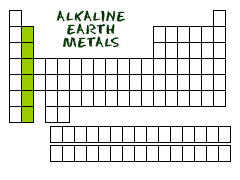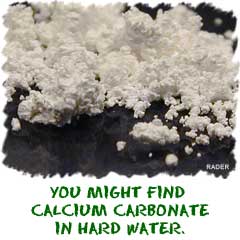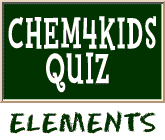
Heading to Group Two
 So we just covered the alkali metals in Group I. You will find the alkaline earth metals right next door in Group II. This is the second most reactive family of elements in the periodic table. Do you know why they are called alkaline? When these compounds are mixed in solutions, they are likely to form solutions with a pH greater than 7. Those higher pH levels means that they are defined as "basic" or "alkaline" solutions.
So we just covered the alkali metals in Group I. You will find the alkaline earth metals right next door in Group II. This is the second most reactive family of elements in the periodic table. Do you know why they are called alkaline? When these compounds are mixed in solutions, they are likely to form solutions with a pH greater than 7. Those higher pH levels means that they are defined as "basic" or "alkaline" solutions.
A Family Portrait
 Who's in the family? The members of the alkaline earth metals include: beryllium (Be), magnesium (Mg), calcium (Ca), strontium (Sr), barium (Ba) and radium (Ra). As with all families, these elements share traits. While not as reactive as the alkali metals, this family knows how to make bonds very easily. Each of them has two electrons in their outer shell. They are ready to give up those two electrons in electrovalent/ionic bonds. Sometimes you will see them with two halogen atoms, as with beryllium fluoride (BeF2), and sometimes they might form a double bond, as with calcium oxide (CaO). It's all about giving up those electrons to have a full outer shell.
Who's in the family? The members of the alkaline earth metals include: beryllium (Be), magnesium (Mg), calcium (Ca), strontium (Sr), barium (Ba) and radium (Ra). As with all families, these elements share traits. While not as reactive as the alkali metals, this family knows how to make bonds very easily. Each of them has two electrons in their outer shell. They are ready to give up those two electrons in electrovalent/ionic bonds. Sometimes you will see them with two halogen atoms, as with beryllium fluoride (BeF2), and sometimes they might form a double bond, as with calcium oxide (CaO). It's all about giving up those electrons to have a full outer shell.
As you get to the bottom of the list, you will find the radioactive radium. While radium is not found around your house anymore, it used to be an ingredient in glow-in-the-dark paints. It was originally mixed with zinc sulfide (ZnS). The other elements are found in many items, including fireworks, batteries, flashbulbs, and special alloys. The lighter alkaline earth metals, such as magnesium and calcium, are very important in animal and plant physiology. You all know that calcium helps build your bones. Magnesium can be found in chlorophyll molecules.
Related Video...
Not So Heavy Metal - Beryllium (NASA Video)
Encyclopædia Britannica: Alkaline Earth Metals
Wikipedia: Alkaline Earth Metals
Encyclopedia.com: Alkaline Earth Metals



